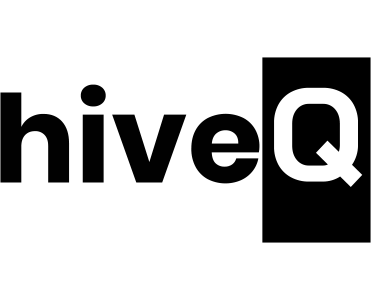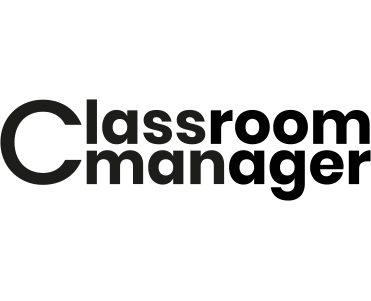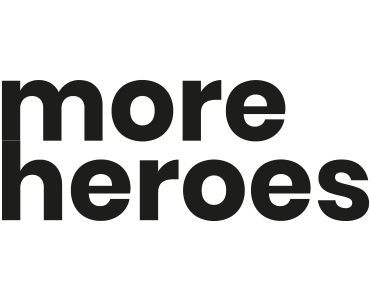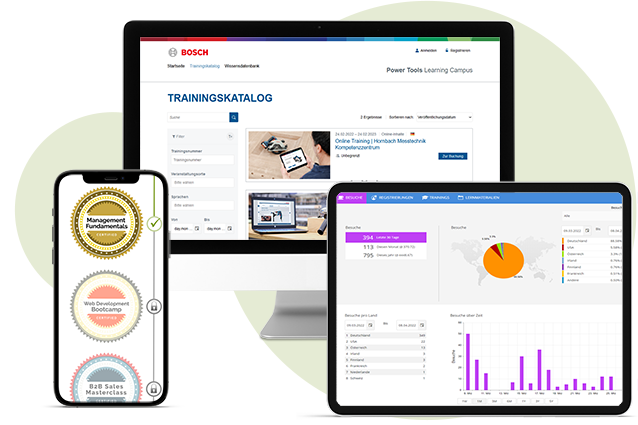eglossar
- API and xAPI
- Authoring tool
- AVV / DPA
- Blended learning
- Didactics
- Digitization
- Edutainment
- e-shop function
- Event management
- Gamification
- Knowledge data base
- LCMS
- Learning Management System (LMS)
- Learning Nugget
- LTI
- LXP
- Microlearning
- MOOC
- Rapid elearning
- Reporting function
- Request form
- SCORM
- Survey and analytics
- Template (elearning)
- Virtual classroom
- WBT
- Webinar
API and xAPI
An Application Program Interface (API) is a language and message format built into an application. It communicates with operating systems or other computer programs, such as ERP applications, in order to share data and functionalities. It helps you to share learning data between multiple applications and systems.
The Experience API (xAPI or Tin Can API) is a new specification that makes it possible to collect data about a person in a consistent format from many different technologies. These distinct systems are able to securely communicate by capturing and sharing a user’s activities using the vocabulary of xAPI. Thus, an activity is recorded and sent as a secure statement in the form of “noun, verb, object”, such as “I did this” to a Learning Record Store (LRS). An LRS records all the statements. It either exists on its own, or inside an LMS. In contrast to SCORM (see below), xAPI records data from anywhere and is not restricted to activities within an LMS.
Authoring tool
An authoring tool is a software that helps users to create elearning or other digital content. Different tools range from low complexity (similar to MS PowerPoint) to high complexity (similar to Photoshop).
AVV / DPA
Auftragsverarbeitungs-Vertrag (AVV) in German, or Data Processing Agreement (DPA) in English, describes a contract following Art. 28 of the General Data Protection Regulation (GDPR). This agreement needs to be signed by any party that acts as data processors on behalf of another party. The contractor is required to process personal data exclusively within the framework of the agreement made and according to the instructions of the client.
Blended learning
Blended learning describes combinations of different learning formats, such as elearning, classroom training and virtual classroom in one training scenario.
Didactics
Didactics is the science of teaching and learning – regardless of its content. It is a core discipline of pedagogy and deals, among other things, with learning objectives, teaching content and appropriate teaching methods. Within didactics, there are different theories: In the past, for example, one predominantly focused on teachers and teaching content. Therefore, front-of-class teaching was very common and learners were not given much consideration. Today, however, didactic theory has turned towards learners, and teachers increasingly align their instruction towards their learners’ needs.
Digitization
Digitization can be construed and defined in various ways. Originally, digitization described the transformation of analogue information into digital formats. Today, the term is often used to describe a process of social change, also called digital transformation, digital change or digital revolution.
Edutainment
Edutainment is a combination of the words education and entertainment and describes an entertaining transfer of knowledge. The goal is to increase motivation for learning and to make learning more efficient and successful. Edutainment exists in very different areas, such as museums or television programs.
e-shop function
This function offers a range of services: simple invoicing to a fully integrated web shop. In its simplest form, invoices can be automatically generated, sent and transferred via an interface. If this is no longer sufficient, it can be extended to a fully integrated web shop. This allows the training portfolio to be displayed in an international context, including country-specific currencies and taxes. In addition to the classic payment methods, online payment systems such as credit card payment, PayPal or instant bank transfer are also covered.
Event management
Event management is one of the main characteristics of an LMS. It handles attendance events including registration, participant lists, trainer organisation and room management.
Gamification
Gamification refers to the integration of game-typical elements into new contexts which are not related to games. These elements include, for example, high scores, rankings, awards, levels or avatars. Gamification can be applied in different areas and aims to influence the behaviour and motivation of users in a positive way. The concept overlaps with other theories from education, such as serious games, edutainment and game-based learning.
Knowledge data base
Basically, a knowledge data base is a media library with different media types such as videos, PDFs, links and many more. It can be made publicly accessible or tailored to specific target groups. Typically, it consists of online content which can be accessed anytime and searched using filters. Some LMS include the functions to recommend, bookmark and rate media provided.
LCMS
A Learning Content Management System (LCMS) is an advancement of a Learning Management System (LMS). An LCMS is specialized in creating, storing, recycling and managing elearning content. While LMS offer a broad variety of functions (provision of elearning, administration of classroom-based courses, payment modules, etc.), content must be created in a separate authoring tool, exported as a SCORM file and loaded onto the LMS. This step is not needed with an LCMS: It allows users to create and edit learning content directly on the platform.
Learning Management System (LMS)
A Learning Management System (LMS) is a software that supports you in managing courses and measuring learning processes. Most LMS include user management, course and event management (online and classroom-based), content integration, automated email notification and certification processes as well as reporting functions. Furthermore, there is a variety of additional features which different LMS may offer, such as competence management helping you to monitor talents, request forms for new courses, surveys to evaluate the training sessions or payment services for priced courses.
Learning Nugget
A Learning Nugget is a short learning unit – usually between 5 and 10 minutes long. It can consist of videos, interactions, texts, quizzes or short learning games. Learning Nuggets can convey demanding learning content, refresh knowledge, deepen a topic or arouse curiosity about further learning opportunities. Thanks to their brevity and the mix of different formats, Learning Nuggets can be integrated into everyday life flexibly and can be used in various (blended learning) scenarios.
LTI
Developed by the IMS Global Learning Consortium, Learning Tools Interoperability (LTI) describes a method for learning systems to communicate with external systems. For instance, an LMS may use LTI to display course content from external systems. In order to access these courses, learners do not need to log in separately on the external systems – the LMS shares information about the learner and learning context with the external systems.
LXP
A Learning Experience Platform (LXP) is a software that focuses on the learning process of its users. With the help of artificial intelligence, an LXP promises a new, personalized learning experience. It includes – among other things – a flexible selection of learning content, social interaction and individually optimized learning paths. Learners decide when they want to learn which content and can use social features, such as chats or statistics with awards. They can further create content autonomously and share it with their colleagues.
An LXP responds to the individual differences and needs of learners. Both an LMS and an LXP are ideal tools for knowledge transfer – the determining factor is what the existing learning culture in the company looks like and what it should look like in the future. The two systems can also complement each other, as an LMS is generally better suited for compulsory courses and qualifications that employees need.
Microlearning
Microlearning is learning in small units, so-called learning nuggets . It describes a current trend in learning: short units, embedded in everyday life, informal, entertaining, flexible and modular, with immediate feedback. In this way, you can keep the motivation and attention of learners high and even busy employees can complete a short unit in between. Furthermore, microlearning elements can be individually adapted to different target groups and updated with little effort.
MOOC
A Massive Open Online Course (MOOC) is an online course with open online access and without any limitation of participants. Usually, they consist of filmed presentations and lectures. Nevertheless, many MOOCs also include interactive elements, such as a user forum or social media discussions.
Rapid elearning
Rapid elearning describes the rapid creation of online learning content. The creation process is simplified and shortened: First, the learning material is clearly defined and structured. Second, the media creation follows a defined set of layout options. For instance, already existing documents, such as PowerPoint presentations, are converted into simple, interactive elearning modules. Thus, it is possible to create professional online learning content in a short time with a small budget.
Reporting function
Reporting helps to monitor and document learners’ performances which can be relevant for legal reasons, especially with regard to compliance training. Usually, reports include the following features: course completion, course subscriptions, last access by user, total time spent on courses and learning media, test scores, payment data, user activity reports, certification reports and survey responses.
Request form
This function integrates request forms for new courses. Trainers who identify a need for an additional training can fill in a request form and suggest frequency, topic and scope of a new course.
SCORM
The Sharable Courseware Object Reference Model (SCORM) is the most widely used e-learning standard. It is a set of technical standards for elearning products that allow a communication between elearning content and LMS. Thus, you can create your courses in any authoring tool, integrate it in your SCORM compliant LMS and obtain reports on your users’ learning performance. SCORM makes sure that content is compatible with an LMS and that an LMS can import, launch and track content.
Survey and analytics
The survey and analytics functions are integrated in most LMS. It allows to conduct surveys – either standardised or customised – in order to retrieve users’ opinions and satisfaction with the training. These surveys can then be evaluated and analysed according to an organisation’s needs.
Template (elearning)
A template in an authoring tool is used to create online learning content. With the help of defined fonts, colours and interactions, the template in an authoring tool is similar to templates in other programs, such as PowerPoint. The main benefit of a template is that you can save time. Additionally, templates also help you to create coherent online courses that follow a similar structure and look alike.
Virtual classroom
A virtual classroom is an online teaching and learning environment where trainers and users can interact, communicate, work in groups together and engage with learning resources. Through a video conferencing application, the virtual classroom takes place anywhere in a live, synchronous setting. Usually, tools in a virtual classroom include: online whiteboard for real-time collaboration, instant messaging, moderator toolkit for interactions and adjoining rooms for smaller group discussions.
WBT
A Web-Based Training (WBT) is a browser-based training that is delivered over the internet or a local intranet. Learners can do this training anywhere and at any time.
Webinar
Similar to the virtual classroom, a webinar (short for “web-based seminar”) takes place in an online, synchronous setting. While definitions of webinars and virtual classrooms overlap to a certain degree, webinars are often understood as virtual presentations with the possibility to ask questions at the end. They often take place with more people (+20) than a session in a virtual classroom. Nevertheless, they can also be conducted with a small group including various tools for communication and interaction.








